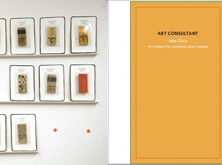April 30 – May 20, 2011, School of the Art Institute of Chicago, Sullivan Galleries Marcel Broodthaers had his Musée d’Art Moderne, Département des Aigles (1968): a museum of his making to counter the art system of the 20th century. It was groundbreaking but quite frankly, analog in comparison to our current state of art and commerce. The system of making an artist and art object from the MFA program to art star, in five steps or less, has gone beyond the level of institutional critique that begins at the museum. Our present art institution runs at hyper-speed, in multiple formats with a viral reach – how to counter the system that has become corporatized and co-opted beyond measure? For Broodthaers, there was still a means of engagement that could be offered up as something counter to the object of his criticism. Today, we are all participants in the system; even those who claim to work from outside the system are actually part of it. All spaces and stands of rebellion have been accounted for. How then to critique? Enter Jennifer Mills, “graduate art student” at SAIC. Through a conflation of her role as both artist and student, Mills performs an elegant double entendre. Part of an ongoing series of investigations on art, commerce and the artist/patron relationship, Mills performs the student in the SAIC program with the result that her MFA thesis exhibition comments on the art system machinery while also producing art objects for consumption. Mills’ position in the art machinery is one that wholly embraces her trajectory – she is aware of how every facet of the system in which she is a part of works to validate her as an artist. Mills does not act to counter this system; rather,...
The Authenticity of Eminem: A Tale of Two Commercials...
posted by Christina Valentine
I believe in Eminem. He says things with Authenticity. Amongst the slate of carefully timed, coiffed, and vetted Super Bowl XLV commercials (no one wants another Janet), Eminem’s brand of honesty – brutally truthful, affectingly honest – seems so real in its honesty. It is an honesty that is singularly Eminem’s. It is in effect, his brand. Rappers have it hard. Their scrappy, hard fought origin is the very thing that makes them successful in their music genre. It is the touting of their survival in the midst of such hardship that is at the core of their identity and their product. It is the classic position of the Other in that the authenticity of the rapper is completely based on his/her alienation and marginalization in society. Once they become successful in the music industry (the platinum records, Grammy awards) their success risks them becoming “soft” and inauthentic to their fanbase. Eminem has negotiated a means around this co-option of toughness. His characteristic refusal to enjoy his celebrity – to be seen enjoying the parties (he may attend but always with his iconic scowl), hanging out with other celebs, and other fluff that is part and parcel of being a celebrity – validates his Otherness and perpetuates his success. In short, he is a celebrity whose very success lies in his manufacture of “authenticity.” It is irrelevant whether or not Eminem actually is honest in the way he navigates through the luxurious excess that his fame brings. What is more significant here is that his brand is all about representing this honesty. In his Brisk Tea commercial, when the “suit” tells Eminem that he can’t re-name the tea to “Eminem’s Shut Up and Drink It! Iced Tea,” Eminem pushes the claymation guy off the...


